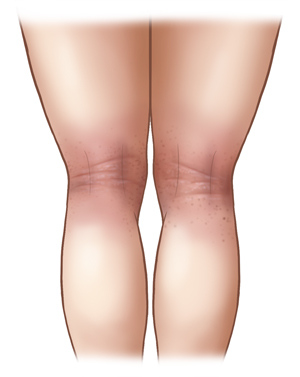Managing Atopic Dermatitis (Eczema)
To manage your symptoms and help reduce the severity and frequency, try these self-care tips:
Caring for your skin
-
Use a gentle, fragrance-free cleanser (or soap substitute cleanser) for bathing. Rinse well. Pat skin dry.
-
Take warm, not hot, baths or showers. Try to limit them to no more than 10 to 15 minutes. Consider limiting bathing or showering to every other day.
-
Use moisturizer liberally right after you bathe, while your skin is still damp.
-
Try not to scratch because it will cause more damage to your skin.
-
Topical, over-the-counter hydrocortisone cream may help control mild symptoms.
-
Be aware that dermatitis can look different depending on skin tone. It may be pink or red if you have pale skin. If you have darker skin, it may look gray, dark red or brown, or purplish color. It may be harder to detect if you have darker skin.
 |
| Eczema on light skin. |
 |
| Eczema on dark skin. |
Controlling your environment
-
Stay out of extreme heat or cold.
-
Stay out of very humid or very dry air.
-
If your home or office air is very dry, use a humidifier.
-
Stay away from allergens such as dust that may be in bedding, carpets, plush toys, or rugs.
-
Know that pet hair and dander can cause flare-ups.
Seeking medical treatment
Another way to keep symptoms under control is to get medical treatment. Talk with your healthcare provider about the type of treatment that may work best for you. Your provider may prescribe treatments such as:
-
Treatments to put on the skin daily
-
Medicines taken by mouth (oral medicines) such as antihistamines, antibiotics, or corticosteroids
-
In severe cases, you may need shots (injections) to control the symptoms. You may even need antibiotics if skin infections occur.
Treatments don’t work the same way for every person. So if your symptoms continue or get worse, ask your healthcare provider about other treatments.
Making lifestyle choices
-
Create daily strategies to manage the stress in your life.
-
Wear loose-fitting cotton clothing that does not bind or rub your skin.
-
Don't wear wool or other scratchy fabrics.
-
Use fragrance-free products.
Next step
Now that you know more about atopic dermatitis, the next step is up to you. Keep your scheduled follow-up appointments. Follow your healthcare provider’s treatment plan and your self-care routine. This will help bring atopic dermatitis under control. If your symptoms persist, be sure to let your healthcare provider know.
Online Medical Reviewer:
L Renee Watson MSN RN
Online Medical Reviewer:
Marianne Fraser MSN RN
Online Medical Reviewer:
Michael Lehrer MD
Date Last Reviewed:
3/1/2022
© 2000-2024 The StayWell Company, LLC. All rights reserved. This information is not intended as a substitute for professional medical care. Always follow your healthcare professional's instructions.